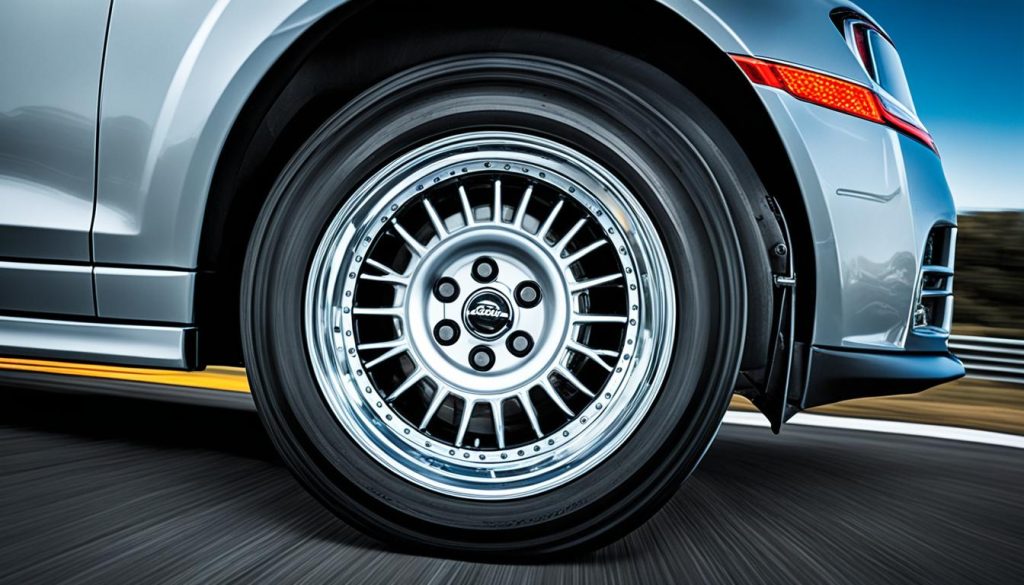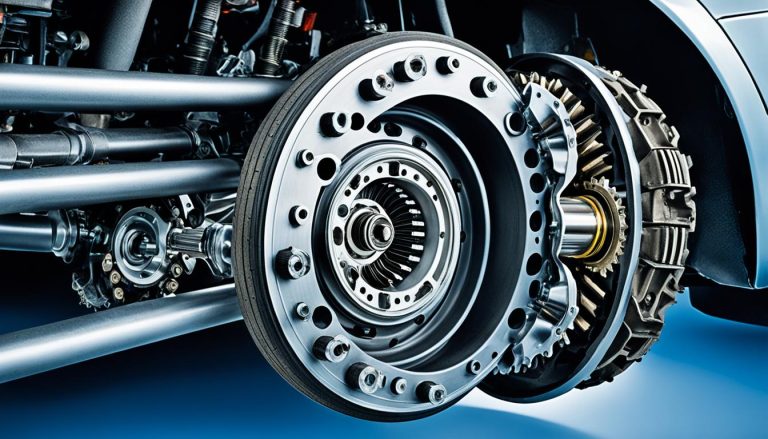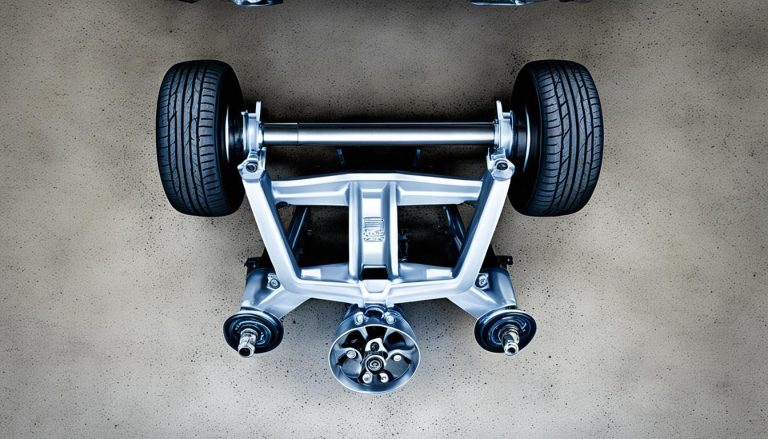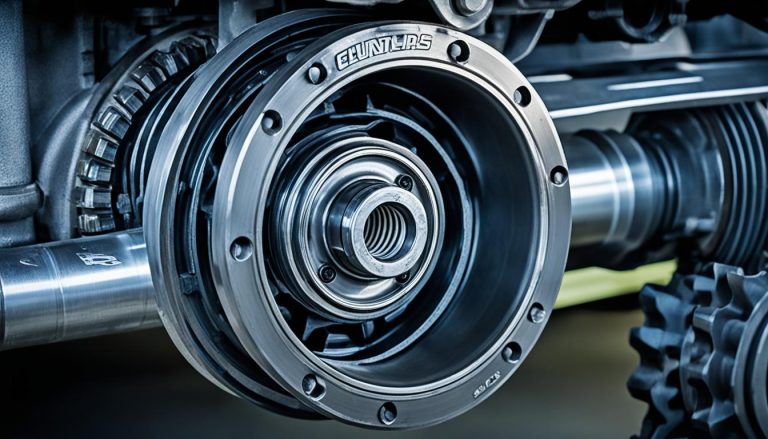3.15 vs 3.75 Limited Slip Rear Axle Explained
If you’re looking to give your vehicle that extra oomph in acceleration or considering improvements to your high-speed cruising capability, understanding the difference between 3.15 and 3.75 limited slip rear axle setups is key. The world of differential gear ratios can deep dive into technical jargon, but fret not! We’re here to clarify the essentials, empowering you to make informed performance upgrades for your rear axle.
Whether you’re behind the wheel of a classic muscle car or a modern sports coupe, the rear axle ratio is a pivotal factor in how your machine responds to your driving demands. Seeking quicker response each time you tap on the gas? Perhaps a 3.75 ratio is your calling. If highway fuel efficiency and serene speed is your jam, then a 3.15 could be the deal-maker. Let’s decode these gear ratios and set you up for the performance you crave.
Key Takeaways
- Grasping the functionality of your limited slip rear axle is vital for any modification.
- A 3.75 rear axle ratio will generally boost your vehicle’s acceleration.
- Choosing a 3.15 rear axle ratio may improve your vehicle’s top speed and fuel efficiency.
- Consider your driving style and vehicle use before selecting a differential gear ratio.
- Comprehending the difference between 3.15 and 3.75 limited slip rear axle will guide you in enhancing your vehicle’s performance.
Understanding Limited Slip Differentials and Their Role in Performance
If you’re looking to enhance your vehicle’s driving capabilities, particularly in high-performance or challenging road conditions, understanding limited slip differentials is essential. Unlike an open differential that may allow one wheel to spin while the other remains stationary, a limited slip differential is designed to improve traction by ensuring that both drive wheels can turn, even when grip is uneven.
Basics of Limited Slip Differentials
At the core of a limited slip differential is the ability to distribute power to the wheels of your vehicle dynamically. It uses a complex system of clutches or a fluid-operated mechanism to redirect extra torque to the wheel with the most traction. This prevents excessive wheel spin during acceleration and offers a significant performance advantage when cornering or driving on slippery surfaces. Understanding limited slip differentials helps in selecting the right rear axle for your vehicle, ensuring that you’ve got the right equipment under the hood for your driving needs.
Benefits of Limited Slip Rear Axle in Vehicles
Installing a limited slip rear axle offers a multitude of benefits for vehicles. Its primary advantage is offering better traction, particularly in low-grip situations such as rain or snow-covered roads. It ensures that power is not wasted on spinning wheels and instead is transferred to the wheel with the best contact with the road surface. This translates into improved safety, more confident handling, and an overall superior driving experience.
Key Benefits Include:
- Better Traction: Reduces wheel slip, providing continuous movement and stability.
- Enhanced Control: Offers consistent driving behavior, improving maneuverability and cornering.
- Superior Performance: Delivers more efficient power transmission, crucial for acceleration and stability during performance driving.
Selecting a limited slip rear axle is also a popular performance upgrade for the rear axle that can be adjusted depending on the desired rear axle ratio. This customization can offer tailored results to match your driving style, whether it be for every day commutes or more aggressive, sporty performance.
| Rear Axle Ratio | Impact on Performance | Suitability |
|---|---|---|
| Lower Numerical Ratio | Higher top speed, reduced acceleration | Highway driving, fuel efficiency |
| Higher Numerical Ratio | Faster acceleration, lower top speed | Performance driving, towing, off-road |
By understanding the benefits of limited slip rear axle, you have the knowledge to make an informed decision on performance upgrades for your rear axle, ensuring optimal vehicle performance and enjoyment.
The Impact of Rear Axle Ratio on Vehicle Dynamics
When it comes to fine-tuning your vehicle’s handling and performance, the rear axle ratio plays a pivotal role, acting as a critical link between the power your engine generates and the level of grip your tires maintain on the road. Altering this ratio is a direct route to achieving notable performance upgrades for your rear axle, impacting your vehicle’s overall dynamics in several key areas.
Opting for a lower gear ratio, which is numerically higher (like 3.75), translates to amplified engine revolutions per minute (RPM) for each rotation of the wheels. This setup boosts your vehicle’s acceleration, providing you with that exhilarating punch off the line that performance enthusiasts crave. However, the compromise comes in the form of decreased top speeds and a potential dip in fuel economy due to the engine working harder at cruising speeds.
Conversely, a higher gear ratio, numerically lower (e.g., 3.15), will provide a different set of benefits, permitting an improvement in fuel efficiency and achievable top speeds. This ratio reduces the engine RPM, making for a smoother and quieter highway cruising experience, but you might feel the trade-off when you demand quick acceleration from a standstill.
Understanding the rear axle ratio is akin to selecting the perfect gear in a multi-speed bicycle: it’s about finding the right balance between the ease of pedaling and the bike’s speed on various terrains—analogous to your vehicle’s performance on the road.
Here’s a glance at how different rear axle ratios can affect vehicle dynamics:
| Rear Axle Ratio | Acceleration | Fuel Economy | Top Speed |
|---|---|---|---|
| 3.75 | Higher | Lower | Decreased |
| 3.15 | Lower | Higher | Increased |
Ultimately, the quest to achieve ideal vehicle dynamics requires a clear understanding of how the rear axle ratio influences your driving experience. Whether your goal is to enjoy brisk acceleration on urban roads or to achieve higher fuel economy for long highway stretches, selecting the suitable rear axle ratio can make all the difference. So, tailor your choice to reflect how and where you drive—after all, it’s about crafting a driving experience that feels just right for you.

Difference Between 3.15 and 3.75 Limited Slip Rear Axle
When it comes to enhancing your vehicle’s performance and towing capabilities, understanding the difference between 3.15 and 3.75 limited slip rear axle ratios is crucial. Each option offers its own set of benefits and can greatly affect aspects like fuel economy, acceleration, and towing efficiency. Here, we break down the distinctions to help you make informed decisions about performance upgrades for your rear axle.

Assessing 3.15 Limited Slip Rear Axle Advantages
The 3.15 limited slip rear axle is well-suited for vehicles that frequently travel on highways and capitalize on steady, high-speed drives. This axle ratio can prove beneficial to your fuel economy, particularly by providing lower engine RPMs at cruising speeds. The decreased engine strain translates to less cabin noise and better mileage, stretching your fuel dollar further. However, if you plan to do a lot of towing, especially with heavy loads or on hilly terrains, this ratio might not be the best fit as it might demand more from your engine.
Exploring the Benefits of a 3.75 Limited Slip Rear Axle
Choosing a 3.75 limited slip rear axle means gearing your vehicle towards more dynamic performance metrics. This ratio excels in providing quick launching power and heightened low-speed response, making it a paragon for drivers seeking to amplify their vehicle’s sportiness. Towing, too, gets a boost with this ratio, as the enhanced torque can more easily handle heavy loads even up steep grades or in demanding, varied traffic scenarios. This performance leap does come with a trade-off as vehicles equipped with a 3.75 ratio often face higher fuel consumption when cruising on long stretches of road due to the increased RPMs needed.
| Aspect | 3.15 Limited Slip Rear Axle | 3.75 Limited Slip Rear Axle |
|---|---|---|
| Fuel Economy | Higher Efficiency at Highway Speeds | Lower Efficiency at Highway Speeds |
| Acceleration | Moderate off-the-line Speed | Improved off-the-line Speed |
| Engine Load | Lower RPM, Less Strain | Higher RPM, Increased Strain |
| Towing Capability | Strains Under Heavy Loads/Hills | Excellent for Heavy Loads/Varied Terrain |
| Road Noise | Quieter Ride | More Audible Engine Sound |
In the quest for the perfect rear axle upgrade, weigh these aspects carefully. Remember, the right choice depends on your specific driving habits, performance goals, and the types of loads you carry. Keep in mind how the limited slip rear axle impacts your overall driving experience and choose a gear ratio that compliments your style and needs. Whether you prioritize fuel thriftiness or the sheer thrill of performance, there’s an axle ratio tailored for your adventures on the road.
Performance Upgrades for Rear Axle: Select the Right Ratio
When it comes to performance upgrades for your rear axle, understanding which upgrade enhances your driving experience is key. Upgrading your rear axle ratio isn’t just about getting better performance; it’s about tailoring your vehicle to suit your driving needs, whether that be for quicker acceleration for an edge on the track or greater fuel efficiency for long road trips.
Selecting the right rear axle for your vehicle plays a pivotal role if you are aiming to improve your car’s pickup. If hustling off the start line and powering through corners is what gets your pulse racing, then a numerically higher rear axle ratio, such as the 3.75, might be your ideal pick.

Conversely, if seamless cruising and fuel economy on the highways are your top priority, you should consider a numerically lower ratio like the 3.15. It’s essential to weigh the types of journeys you commonly make because this influences the performance desired from your vehicle. Below, we break down several factors to consider while selecting the right rear axle ratio.
- Driving Environment: Urban stop-and-go versus open highway cruising necessitate different gears.
- Vehicle Load: Light passenger cars versus heavy work trucks have distinct performance needs.
- Engine Power: Engines with different torque outputs perform better with ratios that complement their power bands.
Manufacturers often design a vehicle’s powertrain to harmonize between all performance elements, ensuring that you experience the drive perfectly balanced for your vehicle’s intended purpose.
To truly optimize your vehicle’s dynamics, a deep dive into its current state, including pavement behavior and power delivery, is a must. However, do not be daunted by the vast sea of numbers and terms. The journey of upgrading your rear axle ratio can be both empowering and enjoyable. By taking the time to educate yourself, you ensure that the final choice leads to a rear axle that performs exactly as you need it to—an extension of your driving intent.
Real-World Applications: What Drivers Should Consider
As you contemplate improving your vehicle’s performance by upgrading your rear axle ratio, there are essential factors and preliminary steps that need your attention. It’s a process that intertwines with the uniqueness of your drive—shifting gears and thrusting power to where it’s needed the most.

Finding Your Current Rear Axle Ratio
To lay the groundwork for any modifications, you must find your current rear axle ratio. This foundational figure can often be unearthed in several ways, such as consulting your vehicle’s documentation for the VIN detail, sifting through the glovebox for production codes, or examining the tag directly embedded on your car’s differential gear set.
For example, GM models have a distinct method of disclosing this data. They use RPO codes which you might stumble upon in the glovebox or on the driver’s door panel. The importance of identifying your current ratio cannot be overstated, as it serves as a benchmark for any enhancement you plan.
Modifications and Effects on Transmission Types
The type of transmission your vehicle boasts plays a pivotal role in deciding on a suitable rear axle ratio. Those with a manual transmission may discover that a ratio like 3.73 hits the sweet spot for performance without compromising the machine’s spirit.
Conversely, vehicles equipped with an automatic transmission might leverage a more robust ratio, such as 4.10 to bolster drivability. The dynamic nature of modern transmissions, which can sport multiple gear ratios, also affects this decision-making process, offering a broader spectrum of efficient speeds and inviting the use of unconventional rear axle ratios.
| Transmission Type | Suggested Rear Axle Ratio | Associated Benefits |
|---|---|---|
| Manual | 3.73 | Enhanced drivability and performance |
| Automatic | 4.10 | Improved acceleration, better control at low speeds |
| Modern Automatic (6-speed+) | Varies | Flexibility, tailored performance and efficiency |
Whether you’re firmly gripping a manual gear-stick or smoothly transitioning with an automatic gearbox, tailoring your vehicle’s rear axle ratio requires a blend of mechanical insight and a dash of personal driving preferences. From the sharp twist on urban roadways to the steadfast cruise down highways, these modifications provide the potential to reshape your vehicle’s character, squarely placing you in command.
Upgrading Rear Axle Ratio: A Guide to Making the Right Choice
When contemplating the upgrading rear axle ratio for your vehicle, it’s imperative to tailor your selection to your driving demands. If your journeys regularly involve towing sizable loads up steep terrains, then the enhanced power from a 3.75 limited slip rear axle might be just what you need. This higher numerical ratio gives your vehicle the torque it craves when pulling heavy weights, embracing the slopes with greater vigor. Conversely, those of you cruising predominantly on highways, appreciating steady drives with lighter cargo, could benefit from the longer legs of a 3.15 gear ratio. Its lower RPM at high speeds works hand-in-hand with fuel economy, granting you a serene, efficient ride.
Choosing the right rear axle for your vehicle isn’t a decision to take lightly. Reflect on the difference between 3.15 and 3.75 limited slip rear axle options in the context of your day-to-day vehicular exploits. If your heart races for rapid accelerations and sprightly performance, then leaning towards the higher ratio aligns with your spirited driving style. However, if serenity, savings at the pump, and endurance are your goals, tip the scales towards the lower ratios. The beauty of a limited-slip differential is its flexibility—adapting to your unique driving narrative, whether punctuated by adventure or penned with pragmatism.
Ultimately, merging your personal driving narrative with mechanical precision ensures a motoring experience that resonates with your lifestyle. Balancing acceleration, top-end velocity, and fuel thriftiness requires insight and personalized tuning. As you journey towards upgrading your vehicle’s capabilities, remember that it’s not just about the parts you choose; it’s about the cohesive harmony they create when fused with your driving essence.
FAQ
What is the difference between 3.15 and 3.75 limited slip rear axle?
The main difference between a 3.15 and a 3.75 limited slip rear axle is their gear ratios. The 3.15 has a higher gear ratio meaning it has lower engine RPMs at a given speed, which is better for fuel economy and top-end speed. The 3.75 has a lower gear ratio, which increases engine RPMs and improves acceleration, making it better suited for performance driving but at a cost to fuel efficiency at highway speeds.
How do limited slip differentials improve vehicle performance?
Limited slip differentials improve vehicle performance by more evenly distributing power between the driven wheels. This results in better traction, especially in low-grip conditions, which enhances acceleration and control during cornering. This differential type helps prevent wheel slip, providing a more stable and responsive driving experience.
What are the benefits of upgrading to a limited slip rear axle?
Upgrading to a limited slip rear axle provides several benefits, including improved traction and handling, better stability during high-performance maneuvers or in poor road conditions, and generally a more secure and engaging driving experience. This is an especially valuable upgrade for performance and sport driving enthusiasts.
Why is the rear axle ratio important for vehicle dynamics?
The rear axle ratio is crucial because it directly affects your vehicle’s acceleration, top speed, and fuel efficiency. A higher ratio (numerically lower, like 3.15) usually means better fuel economy and a higher top speed, suitable for highway driving, while a lower ratio (numerically higher, like 3.75) enhances acceleration, which can be good for towing or sporty driving.
When might a 3.15 limited slip rear axle be advantageous?
A 3.15 limited slip rear axle ratio is advantageous if you’re looking for improved fuel economy and quieter, more efficient high-speed cruising, particularly on highways. This gearing is suited to scenarios involving fewer starts and stops and where towing huge loads is not a primary concern.
What makes a 3.75 limited slip rear axle better for some drivers?
A 3.75 limited slip rear axle is typically preferred by drivers who want increased acceleration and performance. It offers better off-the-line quickness and is useful for towing in conditions where that initial extra torque can assist in moving loads, especially from a stop or on an incline.
How do I determine the right rear axle ratio for my performance upgrade?
To determine the right rear axle ratio for your performance upgrade, consider your vehicle’s current use, typical driving conditions, and whether you prioritize acceleration over fuel efficiency. Choose a higher ratio like 3.75 for better acceleration or a lower ratio like 3.15 for better fuel efficiency and higher top speed, depending on your needs.
What should I know about finding my current rear axle ratio?
To find your current rear axle ratio, you can look for a tag or engraving on the differential, check the vehicle’s VIN with a dealer for specification details, or look for production codes in the glovebox or on the driver’s door panel in the case of vehicles like GM models.
How do rear axle modifications affect different transmission types?
Rear axle modifications can differently affect manual and automatic transmissions. For instance, manual transmissions might perform well with ratios like 3.73, while automatic transmissions might require a higher ratio such as 4.10 to maintain drivability. It’s important to consider the transmission type when selecting a new rear axle ratio.
What factors should I consider when upgrading my rear axle ratio?
When upgrading your rear axle ratio, consider your driving habits, vehicle use, and performance expectations. If you frequently tow or indulge in performance driving and need better acceleration, a numerically higher gear ratio like 3.75 could be ideal. For mainly highway cruising with a focus on fuel efficiency, a lower gear ratio like 3.15 may be more suitable.






